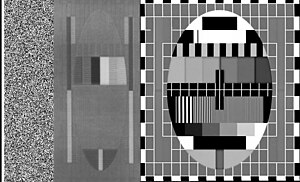

C-MAC is the television technology variant approved by the European Broadcasting Union (EBU) for satellite transmissions.[1][2] The digital information is modulated using 2-4PSK (phase-shift keying), a variation of quadrature PSK where only two of the phaser angles (±90°) are used.[3]
- The data capacity for C-MAC is 3 Mbit/s.
- C-MAC data has to be sent to the transmitter separately from the vision.
- The transmitter switches between FM (vision) and PSK (sound/data) modulation during each television line period.
- ^ RECOMMENDATION ITU-R BO.650-2 - Standards for conventional television systems for satellite broadcasting in the channels defined by Appendix 30 of the Radio Regulations (PDF). ITU. 1992. p. 5.
- ^ Buiting, J. (1990). "Introduction to Duobinary Encoding and Decoding" (PDF). Elektor Electronics. January 1990: 50–52.
- ^ Schlyter, Paul. "MAC (Multiplexed analogue components) in "Analog TV Broadcast Systems"".